The Tomytec Bus System
Anyone who’s been involved in model railroading for any length of time has probably heard of the Faller Car System, a set of motorized road vehicles and related accessories. Originally for HO scale, it now also has a number of N-scale (1:160) vehicles and accessories. The Faller system is based on vehicles with rechargeable batteries and the use of electromagnets to make the vehicles stop (at traffic lights, for example).
Tomytec has recently (Spring, 2011) introduced a very similar system (possibly licensing some of Faller’s technology). The significant difference is that it uses disposable batteries (longer-lasting, but not rechargeable) and permanent magnets for controls, as least for now. It also has a motor unit that can be adapted to drive many of the 1:150 (Japanese N-Scale) bus bodies sold through Tomytec’s Bus Collection (Japanese page). And it uses modular street segments designed to work with Tomix (a Tomytec brand) Wide Tram track (Japanese page), allowing the creation of streets containing light-rail track and moving vehicles, without the need to embed track and guidewire in plaster, or hand-make the same with sheet styrene.
Larger and additional photos are provided in the Tram Layout photo album and also see the Tram Layout page for information about the small layout I’m making using the bus system.
One thing I’ve read online, but can’t confirm since I don’t have any Faller Car System vehicles, is that there is a significant difference between the Faller and Tomytec systems that could cause significant interoperability problems. The Faller reportedly uses a wire atop the roadway (hidden under paint, or at most a very thin layer of styrene) and relatively weak guiding magnets attached to the front wheels. The Tomytec system uses a very strong magnet, and wire attached to the underside of a fairly thick styrene roadway. Apparently Faller vehicles used with Tomytec roads don’t track reliably, and Tomytec vehicles used with Faller wire can seize the wire and not move.
Before planning to use the two systems together, that’s an issue worth doing some research on, or at least googling about to see what others have learned. For now at least, I’m sticking with the Tomytec system, so I don’t feel any need to try to make the two work together.
Starter Set
Initially only a single starter set was available (The Moving Bus System Basic Set A, Item 228233). This set includes eight 70mm straight segments (3 of which are marked for a bus stop), and six each curves of 103mm and 140mm radius, which can form a lopsided single-lane oval. Or you can combine two sets to form a dual lane oval with two bus stops. Each set also includes one motor unit, one painted painted bus shell for a Tōkyō bus, and one unpainted bus shell. The sets are available, if you can find one, from Japanese stores (like Hobby Search) for about US$83, not counting shipping. The set does not include batteries; a pair of Alkaline LR44 cells are needed for the motor unit. The initial run sold out, and a second in August did so as well. There’s also a U.S. source for these (likewise sold out as of fall 2011, and at a 20% higher cost, but that’s mostly offset by lower shipping costs).
Note that to build a tramway in the median of a two-lane road you’d need more than just this basic set, as the roadway has two adjacent lanes (C103 and C140). At a minimum you’d need a C177 roadway curve for one C140 track in the middle, and C214 for a dual-lane road with two tracks (C140 and C177) down the middle, at Tomix’s usual 37mm spacing. You can also go smaller with C66 and C140 roadway, and a C103 tram track in the middle, assuming you’re using short trams that can negotiate a 103mm (4”) curve.
As of July 2011 separate packs of C66, C103, C140, C177 and C214 radius roadway were announced for November release, along with the curves and straights previously only available in the basic set.
They have subsequently introduced other sets for an Osaka Hino (set A2), a Meitetsu line Mitsubishi Fuso used in Nagoya, Hiroshima and Fukuoka (B1), a Hiroden Hino used in Hiroshima (B2) and a Nishitetsu Mitsubishi Fuso used in Nagoya, Hiroshima and Fukuoka (B3). And they’ve been pretty good about keeping these in production, although at times they’ll be out of stock. Some of these sets differ in the exact contents, but I don’t have any of them to confirm the lists shown on hobby-store sites.
Check out this link for HS’s current status of parts in this line.
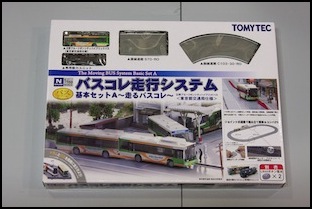
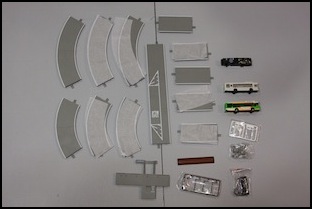
More roadway elements, and more vehicles, are likely in the future.
The Bus
The bus included in the A1 starter set is a model of a Tōkyō Metropolitan Government Bureau of Transportation (Toei) Hybrid version of the Hino Blue Ribbon bus, built by Hino Motors.
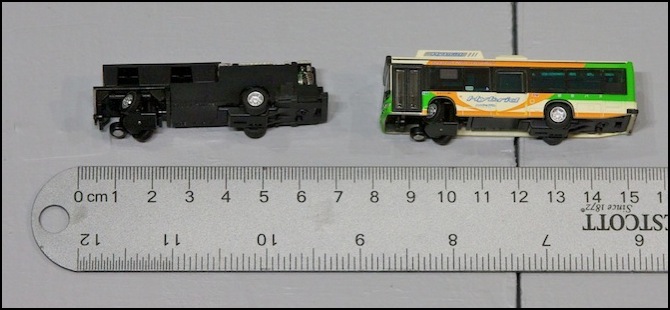
Motor alone (left) and with bus shell attached (right)
The motor comes with three sets of adapter brackets, which allow it to be used with several other bus shells made by Tomytec, including the 96MC “non-step” bus, a low-floor bus that allows wheelchair access via an extensible ramp, rather than a lift. There’s also an unpainted shell in case you want to make your own design or reproduce one not sold by Tomytec.
Streets and Track
Tomix Mini-Rail FineTrack is built around a system of 70mm and 140mm straight segments and curves of 177mm (7”), 140mm and 103mm (4”); the latter sharp enough that most articulated trams can’t follow them. the Wide-Tram version of this has the track embedded in 5mm high paved surfaces that can snap together at the sides to produce parallel lines. This is relatively recent, and only a small variety of track is presently available, but it can also interconnect with other types of non-street FineTrack, which opens up considerably more opportunities.
And, as you can see from the groove on the underside, provision has been made for a bus guidewire, which suggests Tomytec will eventually introduce a wide-tram/roadway piece. The nickel-silver alloy used for the rails does not attract the magnet used to guide the bus, so mixing road and track should work.


Wide Tram S140 track (note the rail is continuous, even though two 70mm bases are used)
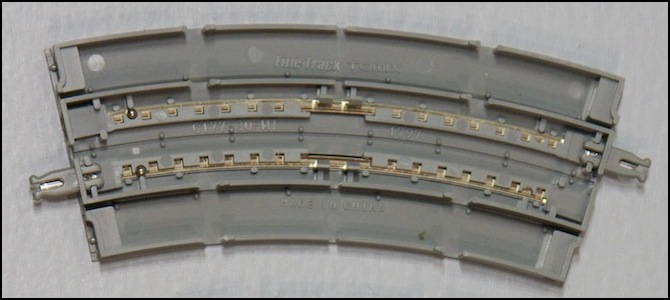
And wide-tram C177-30 curve
The Bus System roadway segments are very similar, and can be intermixed with the Wide Tram track segments. Note that the roadway includes white lane markings at the edge. And, on the underside, there are multiple places the wire could be run. The bus stop already makes some use of these, but it looks like you could potentially have two lanes share a single 37mm-wide segment.
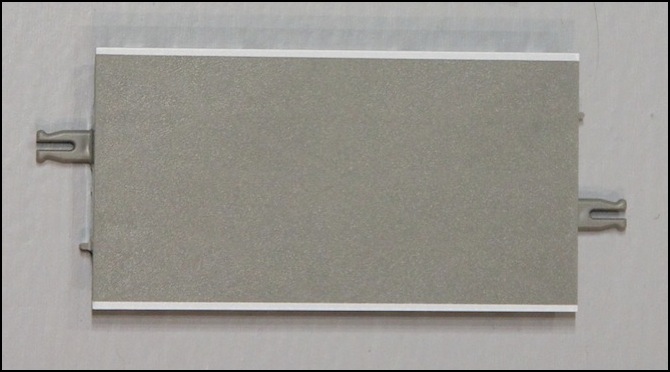
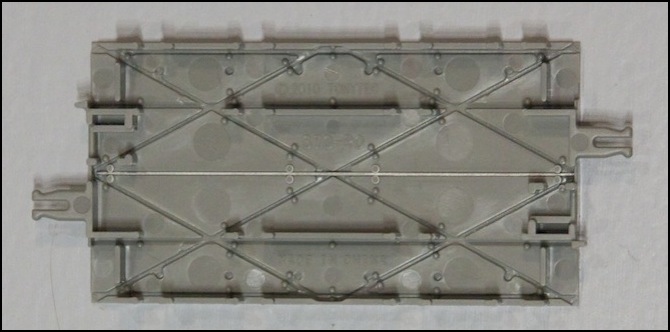
70mm Roadway segment (S70-RO) with underside showing guidewire
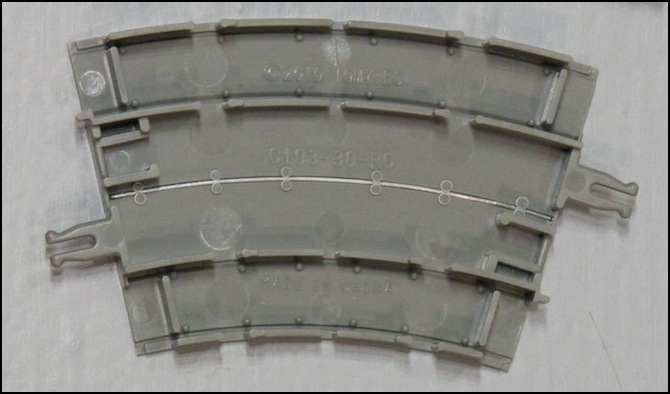
C103-30 Roadway segment (note the lack of diagonal grooves, but it does share the straight road’s potential for two lanes.
Control
The bus itself has only one control, a push-button on the underside to start and stop the motor. With the motor running, the magnet attached to the front wheels will cause the bus to follow the metal wire under the roadway. Wire sold for the Faller system works on the same principal, and can almost certainly be used if you wanted to make your own roads instead, although as noted above the magnet strength is different so you likely can’t mix the two kinds of vehicles on one system, and mounting Faller wire is probably going to be slightly different.
The Tomytec system includes two magnets that clip to the underside of the roadway. When placed to the right side of the middle of the road (as viewed from the perspective of the bus) these will cause the motor to change from low speed to high speed or vice versa (although the two aren’t substantially different, they are different enough to be noticeable).
There are two more magnets used in the bus stop. When placed under the center of the path of the bus, the long magnet (a permanent part of the bus stop) causes the bus to come to a stop until the magnet is removed (by pushing it to one side with a lever). However, if the second magnet is clipped to the bus stop, placing it under the center of the bus as the bus approaches the stop, the bus will stop over the long magnet, but restart on it’s own 7 seconds later (some documents say 10 seconds; mine stops for 7).
Because the bus always follows the wire, and the wire is in a fixed position under the bus stop, the bus will always pull into the bus stop, even if the lever is set to “go” (which moves the magnet out from under the route of the bus, preventing it from stopping the bus). This looks a little unprototypical.
Summary
A bus alone, moving on a road with otherwise stationary vehicles is going to look out of place. Tomytec needs to introduce more vehicles (hopefully including cars, although the necessary miniaturization may be beyond the current technology) as well as more varieties of roadway. Some more sophisticated control systems (e.g, traffic lights with electromagnetic stop controls like Faller’s) would also be useful. However, as an accent to a carefully-planned scene on a layout, or a diorama, this may be a very handy thing to have as it stands. I’m already planning to make use of it for the bus terminal underneath my elevated Urban Station, although I haven’t worked out all of the details yet, and I’ve now begun work on a separate coffee-table layout as well.
Grades
The bus can climb a substantial grade, or can it? Testing with an inclined board two feet in length showed that with a gentle easement from flat to incline it could climb at least a 30% grade, and could climb a 20% grade without serious degradation in performance. Tests were performed with relatively new but not fresh batteries and with a magnet at the start of the easement curve, so the bus was at full speed by the time it began to climb.
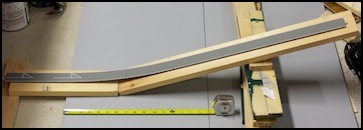
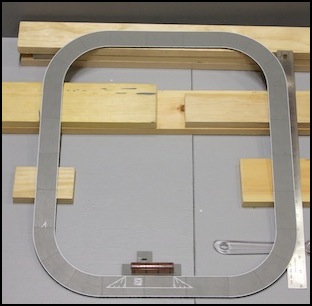
Test grades: set to 7.5” rise in 24”, ~30% grade (left) and an oval with a 12.5% grade (right)
The roadway surface is lightly textured, not slick. Using it, grades up to 10% were climbed with no issue whatsoever. At 12%, the wheels might have slipped, and at 16% the wheels definitely slipped a few times, but without any visible change in speed or smoothness. At 20% this bus might have briefly paused a couple of times, although that wasn’t clear. At 24%, the motion had some visible jerkiness as the wheels slipped and caught, but the bus was still moving fairly smoothly. Finally, with a 30% grade, the speed was noticeably less and the pauses more obvious, but the bus did still reach the top.
However, when I did some more testing with an oval of track, the bus couldn’t even climb a 15% grade without major slipping, and reducing it to a 12.5% grade didn’t change much. I’m at a loss to explain this. I thought it might be due to a lack of support for the roadway (causing it to sag under the bus, and create a localized steeper grade), but propping up the roadway with a sheet of foam-core didn’t improve things.
More work needs to be done to figure out what’s going on, but for the moment I’ve turned my attention elsewhere and will just use the bus on level roads.
Video
I made a short video illustrating the operation of the bus system.




